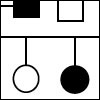Session Overview

|
This session will explain how a collection of mutants with the same phenotype can be used to study a biochemical pathway. In effect, this session outlines how genetics can be used to study biochemistry. It includes a discussion of yeast as a model system. It outlines how to identify mutants with mutations in the same pathway, how to characterize the mutants into complementation groups, and how to use epistasis tests to infer details about a biochemical pathway. Learning Objectives
|
Session Activities
Lecture Video
For this session, watch the video lecture called “Genetics 3” by Prof. Eric Lander recorded in 2004. Then watch the first 7 ½ minutes of the lecture called “Human Genetics.”
Check Yourself
Question 1
A mutant haploid yeast cell that cannot grow without added histidine (mutant 1) is crossed to a wild-type haploid yeast cell (can grow without added histidine). The resulting diploid yeast cell CANNOT grow without added histidine. Which of the following statements is correct?
The phenotype seen in the heterozygotic diploid is dominant.
Question 2
The phenotypes of two haploid tryptophan auxotrophs (trp1 and trp2) are both found to be recessive. These two mutants are crossed and the resulting diploid CAN grow on minimal media. Which of the following statements is correct?
Session Activities
Help Session Videos
First, watch the short video of Genny Gould explaining the concept of Complementation.
Next, watch Genny work a Complementation Problem (PDF) using fruit flies as an example.
Practice Problems
Further Study
Suggested topics for further study in an introductory-level Biology textbook
- Test of dominance
- Test of complementation
- Test of epistasis










